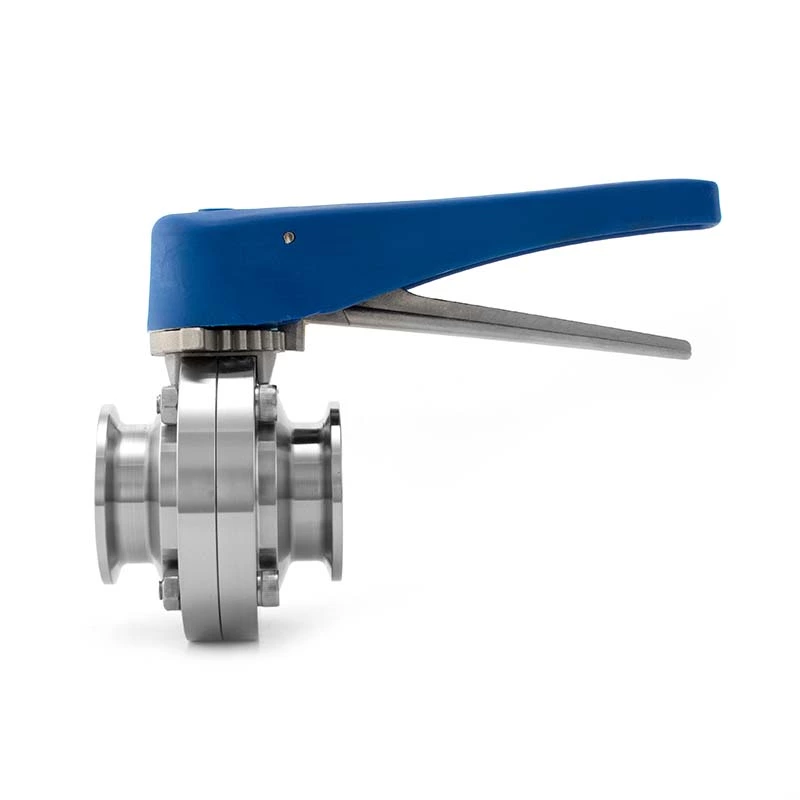Detailed Installation Methods And Techniques Of Pneumatic Butterfly Valve
Sanitary Butterfly Valve The following steps should be taken before installation to make the pneumatic butterfly valve work better.
1. An appearance inspection must be carried out before installation, and the nameplate of the valve should comply with the provisions of the current national standard "General Valve Mark" GB12220. For valves with a working pressure greater than 1.0MPa and that serve as a cut-off on the main pipe, strength and tightness performance tests should be carried out before installation, and they can be used only after passing the test.
2. Before installation, check that all parts of the pneumatic butterfly valve are intact and the model is correct, check that there are no debris in the valve body, and that there is no blockage in the solenoid valve and muffler
3. Put the valve and cylinder in the closed state.
4. During the strength test, the test pressure is 1.5 times the nominal pressure, and the duration is not less than 5 minutes. The valve housing and packing should be leak-free to be qualified.
5. Hit the cylinder against the valve (the installation direction can be parallel or vertical to the valve body), and then check whether the screw holes are aligned. There will not be too much deviation. If there is a slight deviation, just turn the cylinder body a little, and then tighten the screws.
6. After installation, debug the pneumatic butterfly valve (the air supply pressure is 0.4~0.7MPa under normal circumstances). During the debugging operation, the solenoid valve must be manually opened and closed (manual operation is effective only after the solenoid valve coil is de-energized), and the opening and closing of the pneumatic butterfly valve must be observed. If the valve is found to be a little difficult at the beginning of the opening and closing process during the debugging operation, and then normal, it is necessary to reduce the cylinder stroke (adjust the stroke adjustment screws at both ends of the cylinder a little at the same time. When adjusting, the valve needs to be operated to the open position, and then the air source is turned off and adjusted again) until the valve opens and closes smoothly and closes without leakage. It should also be noted that the adjustable muffler can adjust the opening and closing speed of the valve, but it cannot be adjusted too small, otherwise it may cause the valve to fail to operate.
7. The valve should be kept dry before installation and should not be stored in the open air.
8. Before installing the butterfly valve, check the pipeline to ensure that there is no foreign matter such as welding slag in the pipeline.
9. The manual opening and closing resistance of the butterfly valve body is moderate, and the butterfly valve torque matches the selected actuator torque.
10. The flange specifications for butterfly valve connection are correct, and the pipe clamp flange is consistent with the butterfly valve flange standard. It is recommended to use a special flange for butterfly valves, and flat welding flanges are not allowed.
11. Confirm that the flange welding is correct. Do not weld the flange after the butterfly valve is installed to avoid scalding the rubber parts.
12. The installed pipeline flange should be centered and aligned with the butterfly valve.
13. Install all flange bolts and tighten them by hand. Confirm that the butterfly valve and the flange are already centered, and then carefully open and close the butterfly valve to ensure flexible opening and closing.
14. Open the valve to the maximum, tighten the bolts with a wrench in diagonal order, without a gasket, and do not tighten the bolts too much to prevent serious deformation of the valve ring and excessive opening and closing torque.
15. During installation, the valve disc should be stopped in the closed position. The opening position should be determined according to the rotation angle of the butterfly plate. For butterfly valves with bypass valves, the bypass valve should be opened before opening. Pneumatic butterfly valves should be installed according to the manufacturer's installation instructions. Heavy butterfly valves should be installed on a solid foundation. The installation position, height, and inlet and outlet directions must meet the design requirements. Note that the direction of the medium flow should be consistent with the direction of the arrow marked on the valve body, and the connection should be firm and tight.
